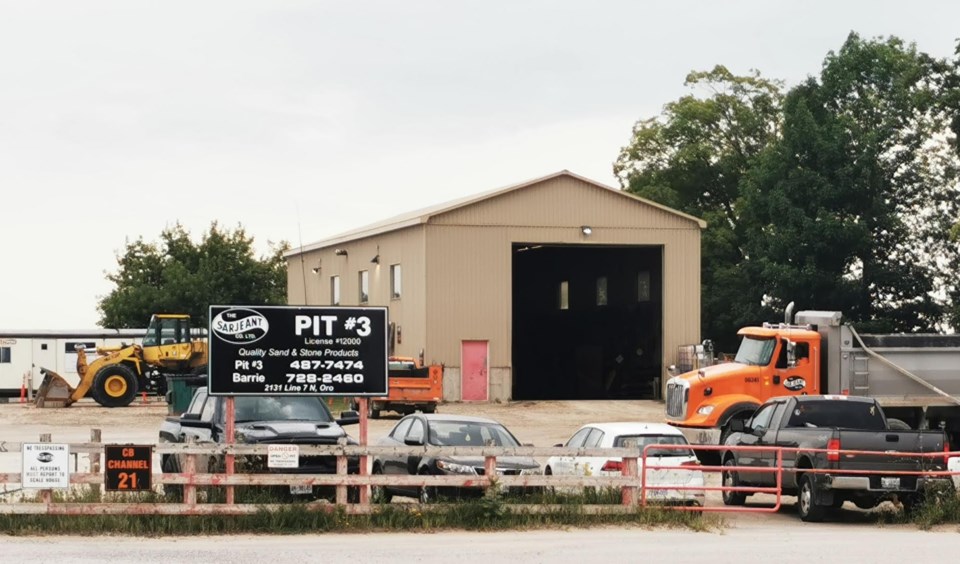Editor's note: The following is Part 1 in a series. Part 2 will follow on Sunday.
One hundred and twenty eight million metric tonnes.
That’s how much aggregate has been harvested in Simcoe County over the last 10 years, according to The Ontario Aggregate Resource Corporation (TOARC).
That’s enough material to build 3,556 kilometres of four-lane highway, TOARC says. Or 1,361 hospitals. Or 512,000 homes.
In 2022, the most recent year of reported results, Simcoe County was the single largest producer of aggregates — 15.2 million metric tonnes — among the province’s upper-tier municipalities.
Of those 15.2 million metric tonnes, Severn Township produced 5.4 million, followed by Ramara Township (3.3 million), Oro-Medonte Township (2.3 million), Clearview Township (1.6 million), Springwater Township (950,000), and Tiny Township (570,000), while Adjala-Tosorontio Township and the Town of New Tecumseth combined for 513,869. The towns of Midland and Penetanguishine together produced 350,000, with Tay Township chipping in at 205,000. The towns of Collingwood and Innisfil, combined with Essa Township, produced 51,000.
According to the Ontario Ministry of Natural Resources and Forestry’s pits and quarries online resource, there are about 20 active pits in Springwater, with a similar number in Oro-Medonte. Essa has a half-dozen active pits.
Mike McSweeney, executive director of the Ontario Stone, Sand and Gravel Association (OSSGA), says the region’s extensive aggregate deposits play a key role in supplying the necessary material while minimizing greenhouse gas emissions and road damage caused by its haulage.
“One of the principles that underlie our 2050 net-zero plan is to source aggregate as close as possible to where it is used,” McSweeney said in an email to BarrieToday. “To do otherwise would create excess greenhouse gas emissions through transportation further than is necessary.”
With the Ontario government’s goal to add 1.5 million new homes in Ontario by 2031, aggregate will continue to be in huge demand. To achieve the target, about 375,000,000 metric tonnes will be needed, based on TOARC’s estimate that 250 tonnes of aggregate are required to build a new home.
McSweeney says homes are just one part of the increased need for aggregates in the province.
“Ontario needs aggregate to supply the most aggressive infrastructure investments that all governments are making in Ontario, in addition to planning for the new 1.5 million homes that will be required,” he said.
That could present challenges, as good quality aggregate isn’t instantly available, McSweeney added.
Not everyone agrees.
James Seeley, mayor of Puslinch and chair of Top Aggregate Producing Municipalities of Ontario (TAPMO), said there isn’t enough information on available aggregate stocks to reach a conclusion.
“The province has to do a holistic review of the aggregate that’s available,” he said. “Right now, nobody will disclose the amount of resource available due to ‘competitive reasons’ in the industry — they don’t want each other to know how much they really have.”
McSweeney disagrees.
“The companies that produce aggregates are a business — to have some suggest that there is an over supply of aggregates doesn’t make sense,” he said. “Why would a business go to the expense of extracting aggregate and just letting it sit as inventory?”
While Seeley and McSweeney disagree on how much aggregate exists, they do agree that a review is required.
“Our industry and governments need to provide more and better information about supply and demand, so that everyone understands that there is in fact a short supply of high-quality, close-to-market aggregate,” McSweeney said.
To understand what McSweeney means, you have to drill down to discover not all aggregates are created equal.
“The aggregate used in road construction must meet very detailed specifications,” McSweeney explained. “These will include the chemical composition of the aggregate material, the size of the material as well as the consistency.
“Different materials are used in the base of the road, in the asphalt and in the concrete used for the sidewalks, curbs and roundabouts.”
McSweeney said some aggregate sites will contain layers of different material with varying qualities found at different levels, or benches, within the same site. That material has to be excavated, sorted and then sold based on its properties.
Sand is defined as a hard, naturally occurring granular rock material that is finer than gravel and coarser than dust and is used to make concrete, asphalt pavement, mortar, plaster and glass.
Gravel is considered to be small, naturally occurring stones and pebbles, or a mixture of sand and small stones, which is used directly in driveways, walkways and decorative landscaping. It’s also used to make concrete and asphalt pavement.
Clay/shale is fine-grained, naturally occurring earthy material used to make bricks and ceramics. It’s also one of the ingredients in cement.
Between 2010 and 2014, almost 79 per cent of all aggregates harvested in Ontario were used in construction projects. Thirty-one per cent was used for new roads and highways. Fourteen per cent was used for new home, condo and apartment construction. Twelve per cent was used for non-residential building and another 12 per cent was used for road and other construction repair. The remaining 10 per cent was used to construct new infrastructure.
Nineteen per cent of the total aggregate production in Ontario is used for non-construction projects, like sand for road ice control, abrasive cleaners and glass.





